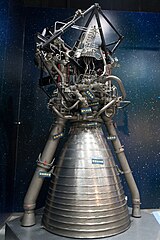A tripropellant rocket is a rocket that uses three propellants, as opposed to the more common bipropellant rocket or monopropellant rocket designs, which use two or one propellants, respectively. Tripropellant systems can be designed to have high specific impulse and have been investigated for single-stage-to-orbit designs. While tripropellant engines have been tested by Rocketdyne and Energomash, no tripropellant rocket has been flown.

A hypergolic propellant is a rocket propellant combination used in a rocket engine, whose components spontaneously ignite when they come into contact with each other.
A liquid air cycle engine (LACE) is a type of spacecraft propulsion engine that attempts to increase its efficiency by gathering part of its oxidizer from the atmosphere. A liquid air cycle engine uses liquid hydrogen (LH2) fuel to liquefy the air.
A propellant is a mass that is expelled or expanded in such a way as to create a thrust or another motive force in accordance with Newton's third law of motion, and "propel" a vehicle, projectile, or fluid payload. In vehicles, the engine that expels the propellant is called a reaction engine. Although technically a propellant is the reaction mass used to create thrust, the term "propellant" is often used to describe a substance which contains both the reaction mass and the fuel that holds the energy used to accelerate the reaction mass. For example, the term "propellant" is often used in chemical rocket design to describe a combined fuel/propellant, although the propellants should not be confused with the fuel that is used by an engine to produce the energy that expels the propellant. Even though the byproducts of substances used as fuel are also often used as a reaction mass to create the thrust, such as with a chemical rocket engine, propellant and fuel are two distinct concepts.
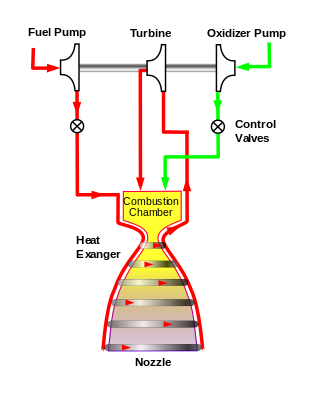
The expander cycle is a power cycle of a bipropellant rocket engine. In this cycle, the fuel is used to cool the engine's combustion chamber, picking up heat and changing phase. The now heated and gaseous fuel then powers the turbine that drives the engine's fuel and oxidizer pumps before being injected into the combustion chamber and burned.
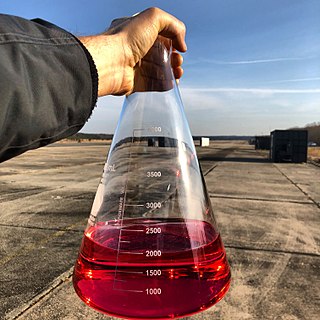
RP-1 (alternatively, Rocket Propellant-1 or Refined Petroleum-1) is a highly refined form of kerosene outwardly similar to jet fuel, used as rocket fuel. RP-1 provides a lower specific impulse than liquid hydrogen (LH2), but is cheaper, is stable at room temperature, and presents a lower explosion hazard. RP-1 is far denser than LH2, giving it a higher energy density (though its specific energy is lower). RP-1 also has a fraction of the toxicity and carcinogenic hazards of hydrazine, another room-temperature liquid fuel.

A liquid-propellant rocket or liquid rocket utilizes a rocket engine that uses liquid propellants. Gaseous propellants may also be used but are not common because of their low density and difficulty with common pumping methods. Liquids are desirable because they have a reasonably high density and high specific impulse (Isp). This allows the volume of the propellant tanks to be relatively low. The rocket propellants are usually pumped into the combustion chamber with a lightweight centrifugal turbopump, although some aerospace companies have found ways to use electric pumps with batteries, allowing the propellants to be kept under low pressure. This permits the use of low-mass propellant tanks that do not need to resist the high pressures needed to store significant amounts of gasses, resulting in a low mass ratio for the rocket.
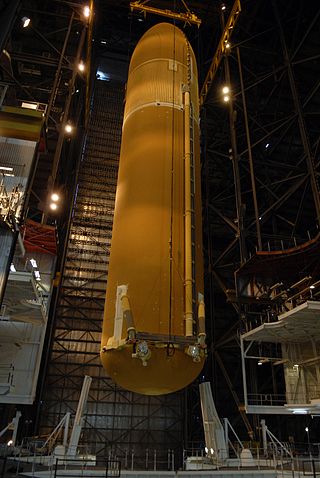
The Space Shuttle external tank (ET) was the component of the Space Shuttle launch vehicle that contained the liquid hydrogen fuel and liquid oxygen oxidizer. During lift-off and ascent it supplied the fuel and oxidizer under pressure to the three RS-25 main engines in the orbiter. The ET was jettisoned just over 10 seconds after main engine cut-off (MECO) and it re-entered the Earth's atmosphere. Unlike the Solid Rocket Boosters, external tanks were not re-used. They broke up before impact in the Indian Ocean, away from shipping lanes and were not recovered.

The F-1, commonly known as Rocketdyne F-1, was a rocket engine developed by Rocketdyne. This engine uses a gas-generator cycle developed in the United States in the late 1950s and was used in the Saturn V rocket in the 1960s and early 1970s. Five F-1 engines were used in the S-IC first stage of each Saturn V, which served as the main launch vehicle of the Apollo program. The F-1 remains the most powerful single combustion chamber liquid-propellant rocket engine ever developed.

The J-2, commonly known as Rocketdyne J-2, was a liquid-fuel cryogenic rocket engine used on NASA's Saturn IB and Saturn V launch vehicles. Built in the United States by Rocketdyne, the J-2 burned cryogenic liquid hydrogen (LH2) and liquid oxygen (LOX) propellants, with each engine producing 1,033.1 kN (232,250 lbf) of thrust in vacuum. The engine's preliminary design dates back to recommendations of the 1959 Silverstein Committee. Rocketdyne won approval to develop the J-2 in June 1960 and the first flight, AS-201, occurred on 26 February 1966. The J-2 underwent several minor upgrades over its operational history to improve the engine's performance, with two major upgrade programs, the de Laval nozzle-type J-2S and aerospike-type J-2T, which were cancelled after the conclusion of the Apollo program.
The highest specific impulse chemical rockets use liquid propellants. They can consist of a single chemical or a mix of two chemicals, called bipropellants. Bipropellants can further be divided into two categories; hypergolic propellants, which ignite when the fuel and oxidizer make contact, and non-hypergolic propellants which require an ignition source.

The staged combustion cycle is a power cycle of a bipropellant rocket engine. In the staged combustion cycle, propellant flows through multiple combustion chambers, and is thus combusted in stages. The main advantage relative to other rocket engine power cycles is high fuel efficiency, measured through specific impulse, while its main disadvantage is engineering complexity.

The Aerojet M-1 was one of the largest and most powerful liquid-hydrogen-fueled liquid-fuel rocket engine to be designed and component-tested. It was originally developed during the 1950s by the US Air Force. The M-1 offered a baseline thrust of 6.67 MN and an immediate growth target of 8 MN. If built, the M-1 would have been larger and more efficient than the famed F-1 that powered the first stage of the Saturn V rocket to the Moon.

The YF-73 was China's first successful cryogenic liquid hydrogen fuel and liquid oxygen oxidizer gimballed engine. It was used on the Long March 3 H8 third stage, running on the simple gas generator cycle and with a thrust of 44.15 kilonewtons (9,930 lbf). It had four hinge mounted nozzles that gimbaled each on one axis to supply thrust vector control and was restart capable. It used cavitating flow venturis to regulate propellant flows. The gas generator also incorporated dual heat exchangers that heated hydrogen gas, and supplied helium from separate systems to pressurize the hydrogen and oxygen tanks. The engine was relatively underpowered for its task and the start up and restart procedures were unreliable. Thus, it was quickly replaced by the YF-75.
The YF-75 is a liquid cryogenic rocket engine burning liquid hydrogen and liquid oxygen in a gas generator cycle. It is China's second generation of cryogenic propellant engine, after the YF-73, which it replaced. It is used in a dual engine mount in the H-18 third stage of the Long March 3A, Long March 3B and Long March 3C launch vehicles. Within the mount, each engine can gimbal individually to enable thrust vectoring control. The engine also heats hydrogen and helium to pressurize the stage tanks and can control the mixture ratio to optimize propellant consumption.

The YF-77 is China's first cryogenic rocket engine developed for booster applications. It burns liquid hydrogen fuel and liquid oxygen oxidizer using a gas generator cycle. A pair of these engines powers the LM-5 core stage. Each engine can independently gimbal in two planes. Although the YF-77 is ignited prior to liftoff, the LM-5's four strap-on boosters provide most of the initial thrust in an arrangement similar to the European Vulcain on the Ariane 5 or the Japanese LE-7 on the H-II.
The RD-701 is a liquid-fuel rocket engine developed by Energomash, Russia. It was briefly proposed to propel the reusable MAKS space plane, but the project was cancelled shortly before the end of USSR. The RD-701 is a tripropellant engine that uses a staged combustion cycle with afterburning of oxidizer-rich hot turbine gas. The RD-701 has two modes. Mode 1 uses three components: LOX as an oxidizer and a fuel mixture of RP-1 / LH2 which is used in the lower atmosphere. Mode 2 also uses LOX, with LH2 as fuel in vacuum where atmospheric influence is negligible.
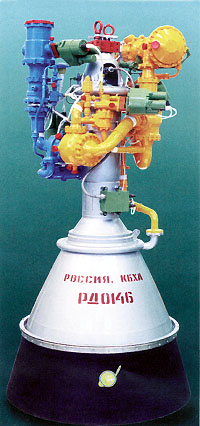
The RD-0146 (РД-0146) is a liquid-fuel cryogenic rocket engine developed by KBKhA Kosberg in Voronezh, Russia.
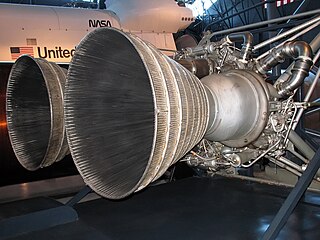
The LR87 was an American liquid-propellant rocket engine used on the first stages of Titan intercontinental ballistic missiles and launch vehicles. Composed of twin motors with separate combustion chambers and turbopump machinery, it is considered a single unit and was never flown as a single combustion chamber engine or designed for this. The LR87 first flew in 1959.

Rocket propellant is the reaction mass of a rocket. This reaction mass is ejected at the highest achievable velocity from a rocket engine to produce thrust. The energy required can either come from the propellants themselves, as with a chemical rocket, or from an external source, as with ion engines.


